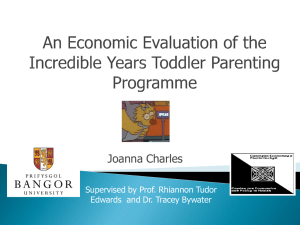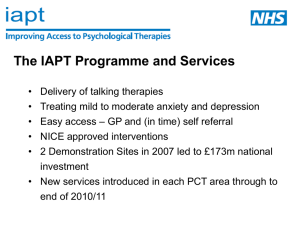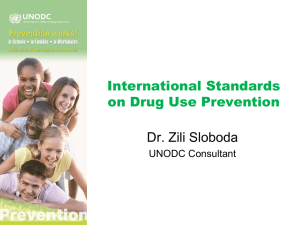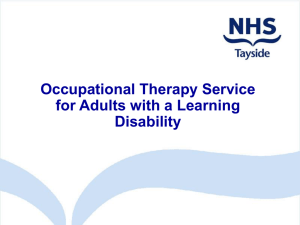Evidence to support improved outcomes for
advertisement
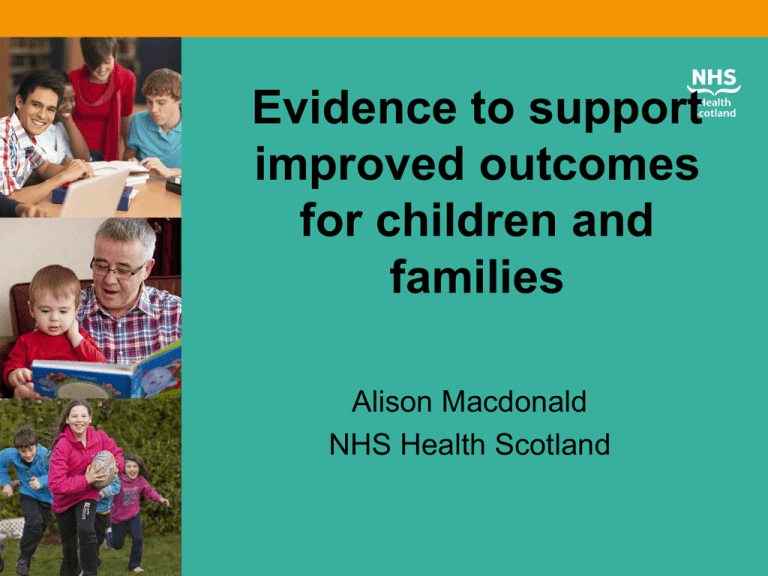
Evidence to support improved outcomes for children and families Alison Macdonald NHS Health Scotland The evidence • Evidence work to inform the development of an outcomes framework for the National Parenting Strategy • Covers the risk and protective factors and effective interventions from pregnancy to 5 years • Includes additional evidence drawn from our other EY evidence work. • Modernising Nursing in the Community summaries of review level evidence . – 21 topics aligned with A New Look at Hall 4 and universal pathway (2011) Protective factors of social, emotional and cognitive difficulties (0-5 years) • Positive (protective) factors: High socio-economic status High income Early years education /childcare Parental relationship: married, positive relationship at birth Parenting: positive parenting style Child factors: girl, first born, higher birth weight, older in academic year, higher British Ability Scale Scores , ethnicity (white mother, English only language spoken) Maternal factors: education, older, self-rated health, ever having been in employment, positive about pregnancy. Blank et al., (2012a) Factors linked to increased risk of social, emotional and cognitive difficulties (0-5 years) Low socio-economic status Low income (unemployment, workless household) Housing (social housing, deprived area, housing difficulties) Parental relationship: lone parent, unemployed lone parent, co-habiting, living with stepfather, disagreement between parents on parenting child, high level of conflict Child factors: ethnicity (Indian, Pakistani, Bangladeshi, Black African) Maternal factors: depression, psychopathology, alcohol misuse, smoking during pregnancy, living away from home prior to the age of 17. Factors related to social, emotional and cognitive difficulties (0-5 years) • Most prevalent risk factors - low income linked to lone parent status and living in social housing. • Less prevalent risk factors - ethnicity, maternal and child factors - but these are increased among those with low income or lower social and economic status. • Lack of national data on the prevalence of parenting risk factors • Absolute risk - maternal age, education and health and housing are the factors associated with the highest levels of absolute risk that a child will experience social, emotional and cognitive difficulties. Child poverty impact on health Reducing the impact of factors leading to unequal outcomes Prevent - Fundamental socio-economic and political measures of reducing the gaps in income and power. Structural changes to economic, tax and benefits. Undo - social circumstances are improved through the provision of resources for living, education, employment, and improved living conditions or environment. Mitigate - The progressive universal model of care is the best mechanism to identify and support families with additional needs/ risks. This model supports the implementation of GIRFEC. Includes services offered to all families, such as health visiting and pre-school education, along with the additional/ enhanced services provided to families with specific needs and/ or risks, such as children and family services, FNP and family centres. Promoting positive relationships • Sensitive, responsive care is associated with secure attachment. • Interventions which enhance parental sensitivity are universally effective (including high risk populations) • Most effective interventions are brief and behaviourally focused, e.g. – Encouraging close physical contact i.e. soft carriers and kangaroo care – Providing information on attachment and sensory and perceptual capabilities of infants. Reducing domestic abuse • Routine enquiry can increase rates of disclosure • Counselling and management of care following disclosure • Effective liaison between universal services and other agencies providing support for those experiencing domestic abuse • Evidence about the effectiveness of specific interventions to treat of prevent domestic abuse is very limited. Preventing Unintentional Injuries • Most injuries in the under 5s occur at home • Strong policy, legislation and enforcement are important • Families may lack both the information to enable them to identify/manage risks and the means to purchase and install home safety equipment • Effective interventions combine education with provision of home safety equipment. • Promoting child development Life approach to the early years has been recommended as & course wellbeing provides foundation for healthy development • Providing support to parents, children and families who have different levels of need requires input from a range of services can reduce the risk of poor outcomes for economically disadvantaged children in both the short and longer-term • Interventions can be delivered as part of progressive universal provision or enhanced services • Universal provision enables identification and progression of vulnerable / at risk families to enhanced interventions • Skills, experience and rapport building family of practitioners is essential to assessing / addressing a family’s vulnerability. Home Visiting Home visiting Good quality evidence to suggest that home visiting interventions improve social and emotional wellbeing – Structure and intensity is linked to effectiveness. Structured, intensive interventions delivered by specialist nurses over first 18 months of life most effective (e.g. family nurse partnership) – Lower intensity, peer or lay provider less effective Blank et al., (2012b) Early childhood education / children’s centres • Preschool education shown to reduce disadvantage, especially among poorest families • Quality of provision is key, including staff personal qualities, training, good management and valuing of social development • Full day programmes most effective with most disadvantaged families. Home visiting and early year’s education Long term outcomes: • There is evidence that early childhood interventions, including home visiting and early education, result in lasting improvements in the outcomes of at risk or disadvantaged children. The greatest positive effects include: • Improved cognitive development • Educational success during adolescence • Reduced social deviance • Increased social participation • Smaller improvements in family wellbeing and social-emotional development have also been reported. Enhanced Specialist Programmes Group based parenting programmes: • Evidence indicates effectiveness of group based / media based parenting programmes, (e.g. Incredible Years) in improving emotional and behavioural problems in children aged <=3 years • Remains unclear whether group based parenting programmes effective in preventing onset of problems rather than treating existing ones • Incredible Years & Triple P shown to effectively reduce behavioral problems in children > 3 years. Programme implementation to promote social and emotional development • Professional roles and practice – Staff skills and beliefs about programme – Management support/ flexibility/ clarity of role/ training and supervision – Negative impact of high stress and complex workloads • Organisation and management issues – Partnership approach/ clarity of purpose/ organisation – Negative – financial insecurity • Engaging families – Mother’s perceptions of benefits and quality of intervention – service reputation/ physical and cognitive accessibility/ personal circumstances – Maintaining contact – perceived benefits to children and quality of service – parental involvement and personal reasons – timing of programme • Home-based interventions – relationship with staff key - especially beneficial to parents lacking in emotional support Key Messages • Children’s life circumstances impact on their physical, psychological and wider development from before birth • There is a link between socio-economic disadvantage and health inequalities during the early years; in particular there is an increased risk of unintentional injuries, social emotional and cognitive difficulties • Adverse and complex social factors experienced during pregnancy have the earliest impact on the health of the infant and their mother Key Messages cont… • Effective communication between pregnant women and their carer(s), and in particular continuity of care and carers, improves the antenatal experience of women with complex social needs. • A progressive universal model of care is the mechanism by which families with additional needs/risks may be identified and appropriately supported • Interventions which enhance maternal mental health and wellbeing and those that promote positive parent infant relationships can have long term benefits Key Messages cont… • Effective interventions that may reduce unintentional injuries linked to socio-economic status, combine the provision of home safety equipment and education • Effective interventions to promote social, emotional and cognitive development include: – Pre and postnatal home visiting of vulnerable children and their families, led by suitably skilled health professionals (public health nurses / health visitors - e.g. FNP) – High quality early years childcare and education, (e.g. children's centres – Sure Start) – Enhanced specialist group-based parenting programmes, that have been shown to be effective for secondary and tertiary prevention, (e.g. Triple P, Incredible Years) Key Messages cont… • Programme implementation fidelity is key • Environmental factors, parent’s perceptions of the benefits to families and children and their perception of staff skills influence family engagement and the maintenance of contact • Spacious, well maintained and pleasant facilities that are linked to good public transport are important to maintaining family engagement. Exploration of the information support needs of parents • Parent information/support is undermined when parents feel marginalised • ‘Trust’ shapes how information is sought, received and used - 2 way conversation • Parents respond most positively to personalised information and support – not one size fits all. • Want sufficiently detailed/understandable info re health, illness and chronic/acute conditions • Value peer support/social networks • Source important – respected practitioner, but not automatically accorded trust. Dependent on quality of relationship and past experience. Rejection of TV, radio, newspapers, magazines and commercial publication • Internet valued as secondary source but websites failed to provide bespoke, contextualised information • Highly rate NHS24, SG and NHS “branded” resources but scepticism about credibility of source • Social media not important as a primary source Exploration of the information support needs of parents: http://www.healthscotland.com/uploads/documents/19013-RE001FinalReport1112.pdf Useful links for evidence • Guidance about Effective Interventions to Support Parents, their Infants and Children in the Early Years http://www.scotland.gov.uk/Resource/0041/00413580.pdf • Modernising Nursing in the Community http://www.mnic.nes.scot.nhs.uk/children,-young-peoplefamilies/promoting-health-addressing-inequality/evidencebase.aspx Contact details • eileen.scott1@nhs.net • kate.woodman@nhs.net Learning & Workforce Development • Health Behaviour Change eLearning suite for partners referring to Health Services • Scotland’s Mental Health First Aid for Young People • Improving Health : Developing Effective Practice for children and young people (coming in 2014) Decision-making in Public Health Decisions Health Scotland’s principles Do good Do not harm Fairness Respect Empowerment Social responsibility Accountability Sustainability Participation Openness Health issues Causal factors Effectiveness Risk of harm etc. Evidence Plausible Theory

